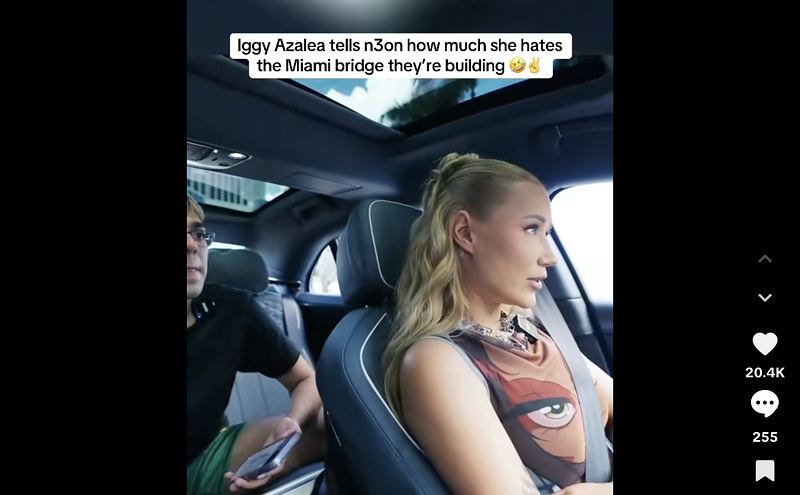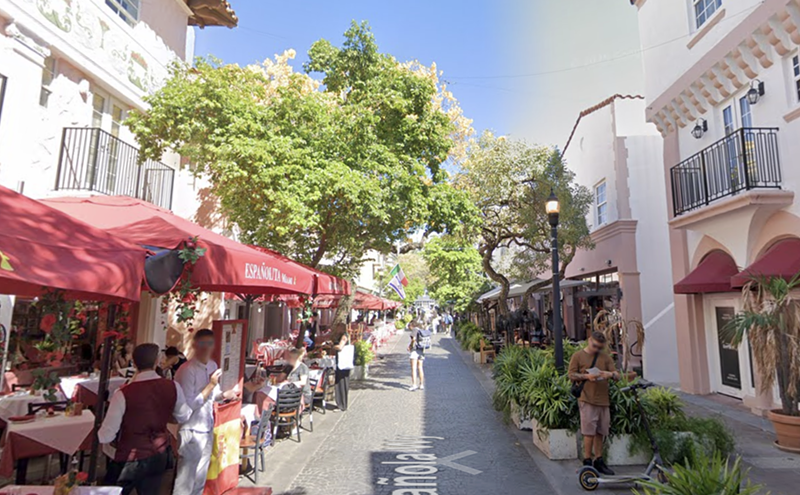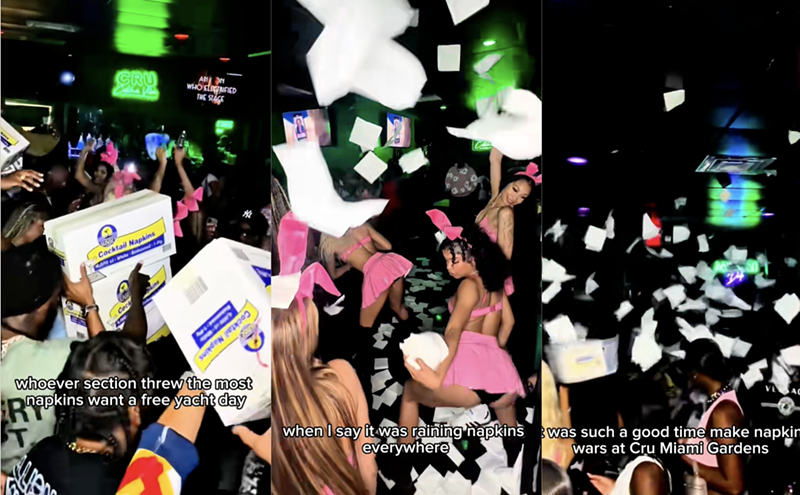I bring up the issue because of a recent public dispute between two Cuban-born Miami artists over the image of a boat made from folded paper. Nosotros-Us was going to be Laura Luna's public art project for a new monument that would join a series of others honoring Cuban history and culture along Memorial Boulevard (SW Thirteenth Avenue) in Little Havana.
A huge cement sculpture of a folded-paper boat (covered with glazed ceramic containing printed text), Luna's piece would have been placed on the boulevard between 20th and 21st streets. But the plan was challenged when artist Leonel Matheu alleged Luna's sculpture was a copy of one of his original designs.
In a June 2 article by El Nuevo Herald reporter Adriana Herrera, Matheu, 38-year-old son of jazz musician Arturo Sandoval, claimed Luna was aware of his designs because some five years ago she had allowed him to use ovens in her ceramics studio to fire a couple of his own porcelain boats. Though the 45-year-old Luna acknowledged helping Matheu, she denied that her sculpture was a copy of his design. "My image doesn't have anything to do with Leonel's symbols. They may have the same shape, but I covered mine with text and the finish is different," she explained.
Matheu countered that the paper boat was "a symbol that has characterized my work for the past twelve years."
Who is right?
Let's go step by step. Paper origami goes back hundreds of years. Sam Randlett in his book The Art of Origami links napkin-folding with the invention of paper in the First Century A.D. We know the Europeans enjoyed boat-folding since the Renaissance (English poet Percy Shelley and French novelist Victor Hugo were origami aficionados).
Paper-boat-folding has been a child's pastime throughout Latin America and particularly in Cuba, where the most important patron saint, La Caridad del Cobre, is famously depicted hovering above three men in a boat during a storm.
After 40 years of refugees making the perilous journey across the Florida Straits, the boat (and the raft) have become icons in the works of contemporary Cuban artists such as Matheu, José Bedia, Los Carpinteros, Arturo Rodriguez, Lydia Rubio, and K-cho, among others.
Exposed to zillions of images (and objects) constantly rehashed within the mainstream, we've become an oversaturated culture of visual connections. Today it is common practice for artists to pick up images, and different ways of presenting them, from other artists' work.
In the Sixties, Andy Warhol reproduced Coca-Cola bottles and Campbell's soup cans and exhibited them as art. In the late Seventies, Richard Prince rephotographed Marlboro ads, while Cindy Sherman took pictures of herself as Barbara Stanwyck, Sophia Loren, and other Sixties female stars. Perhaps the Eighties was the decade of appropriation art, with Sherrie Levine manipulating photographs by Walker Evans and Edward Weston, sculptures by Constantin Brancusi, and paintings by Vincent van Gogh, Piet Mondrian, and many more.
Though artists like Levine, Jeff Koons, Barbara Kruger, and others have been sued for copyright infringement, appropriation has become a legitimate technique for a generation of artists, which in the Nineties included Fred Wilson, Zoe Leonard, Tracey Emin, Lyndal Walker, Maria Kozic, and Glenn Brown -- to name a few. Now they are even appropriating other artists' appropriations.
In some instances a copyrighted photo is used with text over it (Kruger). Some reproduce closeups of images (Levine) or manipulate them (Walker). In other instances the artist pokes fun (Brown) or integrally reproduces the painting with minor changes to bring forth gender or social issues (Wilson).
With appropriation now ubiquitous, who is right in the Luna-Matheu dispute?
Well, it is a fact that Matheu has been using the origami paper-boat image (with a pyramidal sail) in his work for years. But that doesn't make the image his property. It can't be, because he himself took it from a reservoir of images already in the popular mainstream; other Cuban artists before Matheu have used the paper-boat origami with the pyramidal sail.
If Matheu's art consisted only of paper boats, you could accept that that's his lone symbol. But he incorporates the paper boat with other images, such as the square building, the mariner's compass, the old cast-iron bathtub, the five-point star, and a peculiar variation of Mr. Potato Head with a Pinocchio nose. (Matheu comes from a graphic-design background and has a touch for simplifying symbols.) All of these elements together constitute Matheu's style, but it would be ludicrous to presume each is his "property."
Another issue is the previous collaboration between the two artists, which raises the question of artistic influence. Was Luna influenced by Matheu's boat? Given that the boat is not a signature image in Luna's art, I could assume she was influenced by Matheu's work.
And so?
Pablo Picasso did not sue Georges Braque when the latter painted his so-so Grand Nu in 1908 (obviously in the style of Picasso's 1907 Demoiselles d'Avignon). It's also known that Italian Futurism owes much of its formal vocabulary to French Cubism.
Sometimes it's not so easy to pinpoint specific influences. Is Philip Johnson's Glass House a rip-off of Mies van der Rohe's Farnsworth House? Can one say Eero Saarinen's 1947 Gateway Arch in Saint Louis mimics Le Corbusier's 1921 design for his Palace of the Soviets? Most lounge chairs designed after Le Corbusier's Model B306 are variations on a theme, yet there's no doubt the French architect was influenced by Thonet's 1880 Rocking Chair.
What makes for an influence -- an image or a concept? If Antonio Gaudí's and Hector Guimard's buildings look similar, it is not because they copied each other. Rather they shared similar aesthetic concerns, one of which was how to abstract and "modernize" medieval forms.
I think it's okay, even auspicious, for contemporaries to share elements and stylistic concerns. Think of the commonalities between Fauvism and Expressionism, Picasso's style with the Abstract Expressionists, David Siqueiros's and José Clemente Orozco's murals, Salvador Dali's and Ives Tanguy's landscapes, Arshile Gorky's and Roberto Matta's styles in the Forties, and later, Wifredo Lam's and Matta's styles in the early Fifties.
Another interesting and unusual development is that, as a result of the controversy, a group of artists decided to contribute their views for a show titled "Barquito de papel: Mi amigo fiel" ("Little Paper Boat: My Loyal Friend") at Domingo Padrón Art Gallery in Coral Gables. Each artist's work contains a paper-boat image, a way of communicating the idea that the symbol belongs to everyone and to no one.
Of the works, I liked those devoid of didacticism, such as Elio Villate's painting of a huge wash basin from which a bizarre neighborhood rises, all of it underwater (it's something out of a City of the Lost Children movie set); and Edwin Gutierrez's Proa al Norte (Going North), a painting of a paper boat made of passport pages and lying amid a bunch of crumbled paper flags. Cedey de Jesús Rojas's Testament of a Ship is a sort of conceptual double entendre: A previously folded white paper sheet has each corner held to a black surface with transparent tape to give the illusion it's painted.
Are these artists overreacting? Yes and no. French semiologist Roland Barthes once advocated the idea of déjà lu ("already read") to illustrate that works of art and literature are more like rearrangements of signs already circulating in society than "pure inventions" of creative genius. Of course, that doesn't mean Barthes gave up royalties from his numerous books. For his part, Leonel Matheu has vowed to hire an attorney to protect his interests.
I think David Salle (a notorious appropriation artist) nails the issue of originality when he says, "Originality is in what you choose -- what you choose and how you choose to present it."












